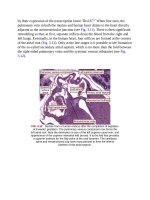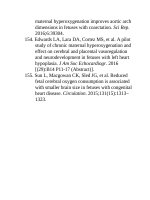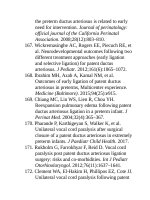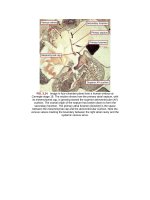Andersons pediatric cardiology 1088
Bạn đang xem bản rút gọn của tài liệu. Xem và tải ngay bản đầy đủ của tài liệu tại đây (151.98 KB, 3 trang )
whentheductislargeandtherecurrentlaryngealnervehasanunusualcourse.
Ligationofthedescendingaortacanoccur,especiallywhentheductis
approachedfromamediansternotomy.Signsofaorticcoarctationmayalsobe
unmaskedafterductalligation.140,141Thisisaconstanthazardinthepremature
infant.Abnormalfindingsafterductalligation,suchasdecreasedfemoralpulses
ordecliningurinaryoutput,shouldpromptrapidreevaluation.
Video-assistedthorascopicclosurewithoutthoracotomyhasbeenarecent
innovation,firstreportedbyLabordeandhiscolleagues.142Clinicalevidenceof
successfulclosurewasfoundinall,althoughtwoattemptswerenecessaryintwo
patients.Damagetotherecurrentlaryngealnerveoccurredinone,andfour
sufferedpneumothorax.Increasingexperiencewiththeprocedurehasreduced
theincidenceofcomplications.Continuedexperiencehasshownthisapproach
toshortenhospitalstayandtoprovideacost-effective,safe,andrapidtechnique
comparedwithopenthoracotomy.143Resultsarecomparablewithtranscatheter
closure.144,145Recentlydevelopedfortheneonateandinfant,atransaxillary
muscle-sparingthoracotomyprovidesexcellentexposureforductaldivision,
produceslesspostoperativepain,andachievesanacceptablecosmeticresult.146
ClosureintheCatheterizationLaboratory(see
alsoChapter18)
ThepercutaneousmethodsforclosurewerepioneeredbyPortsmann,147who
reporteduseofaconicalIvalonplugin1967,withanumbrella-typedevice
subsequentlybeingusedin1979byRashkindandCuaso.148Boththeseimplants
requiredlargesheathsforintroductionandwereoftenassociatedwithresidual
shunting.In1992theuseofspringcoilswasreported,149andduetothe
technicalsimplicityofinsertion,thisbecameawidelyusedtechniqueforclosure
forsmall-to-moderatesizedducts.Intheensuingyears,anumberofdevicesand
techniqueshavebeendevelopedtocloselargerducts.
Asaresult,transcatheterclosurehasbecomethetreatmentofchoiceformost
childrenandadultswithpatentducts.Inparticular,percutaneoustechniques
offerconsiderableadvantagesoversurgicalclosureforpatientswithacalcified
ductal,wallwithorwithoutincreasedpulmonaryvascularresistance,100,150,151
becausethelatteroftennecessitatescardiopulmonarybypass.
Theessentialsofthetechnique,regardlessoftheimplantused,aretoplacea
catheterordeliverysheathacrosstheductfromeitherthepulmonaryarteryor
theaortaandpositiontheimplantintheduct.Severaltechniqueshavebeen
developedtostabilizethecoilsduringdeliverybecausenondetachableGianturco
coilscouldmigrateorassumeunacceptableconfigurationsorpositions.152–154
Varietiesofdetachablecoilsarenowavailable,whichallowcontrolof
positioningpriortotheirrelease(Fig.41.16).
FIG.41.16 Left,DetachableGianturcocoilusedforductalocclusion.Note
theDacronfibers,whichpromotethrombosis,alongitslength.Middleand
right,Retrogradelateralaortogramsbeforeandafterocclusionwithsucha
springcoil.
TheNit-Occlud(pfm—ProduktefürdieMedizin)isaspringcoilspecifically
designedforductalembolization.155Thedesignisbiconical,incontrasttothe
cylindricGianturcocoil(Fig.41.17).TheAmplatzerDuctalOccluder(Abbott)
isaplug-likedesignmadeofnitinolwirewovenintoameshintheshapeofa
mushroom-shapedplug(Fig.41.18;video41.1).Thisdevicecanbeeffectivein
largerducts.156Thedevicehasadetachablecableallowingrepositioningor
retrievalasnecessary.AmodifiedAmplatzerDuctOccluderhasaretentionskirt
withanangleandconcavitytofittheaorticend,andadoubleretentiondisc
designisavailableforclinicaluse.157Otherdevicescurrentlyinuse,orunder
investigation,includeamodifiedbuttoneddeviceandthewirelesspatch
developedbySiderisandassociates.158Forlowbirthweightinfantsand
newborns,smallerdesignshavebecomeavailableforimplantation,aswellasa
varietyofvascularplugstoaddresstheuniqueductalmorphologiesthatmay
present.159Giventhevarietyofductalconfigurationsandsizes,itisapparent
thatnoindividualdevicewillbeoptimalforclosureinallpatients.The
availabilityofavarietyofimplantsenhancesthecapabilitytoclosethemajority
oflesions.
FIG.41.17 Left,Nit-OccludPDAocclusiondevice,withitsbiconical
configuration.Notethereversedwindingontheproximalend.Middleand
right,Lateralaortogramsbeforeandafterocclusionwiththedevice.
(ModifiedfromSchneiderDJ,MooreJW.Patentductusarteriosus.
Circulation.2006;114:1873–1882).
FIG.41.18 Left,AmplatzerDuctOcclude.Notethemesh-likeweave
retentiondiscthatisplacedintheaorticendoftheduct(middle)andthe
controlcable.Right,Newestdesign(DuctOccludeII,Abbott),withtwo
retentiondiscs,designedtoavoidembolization.
Theresultsoftranscatheterocclusionhavebeenexcellentininfantsthrough
adulthood.Completeclosureratesatfollow-upexceed90%to95%inmost
studiesthroughadulthood.160–162Becauseofmodificationsindesign,
developmentofnewtechniques,andincreasedskillofoperators,ratesof
completeclosurehaveimprovedsignificantlyovertime.Seriouscomplications
oftranscatheterclosurearerare.Themostcommoncomplicationisembolization
ofthedevice,whichwasrelativelycommonearlyintheexperiencewithcoils.
Embolizedcoilscanberetrieved,butevenwhentheycannot,adverse









